Table of Contents
In this article, we will be discussing the very popular topic The Plant Cell from the class 09th chapter “The Fundamental Unit of Life: Cell“. This chapter is from the Biology section of class 9th. The fundamental organizational unit of life is the Cell and they are of two types: Plant cells and animal cells. In this article, we will be discussing the plant cell. Plant cells are those cells that help to make up the structure of plants and animal cells, these cells have similarities, but they also have special features that help plants survive where they live.
At the center of each plant cell is the cell wall, a strong layer mostly made of cellulose. This wall supports the plant by giving it strength and helping the cell keep its shape. The Animal cell lacks this cell wall, which provides a distinct appearance to the plant cell.
What is a Plant Cell?
A Plant cell is the basic building block of a plant. It is a special kind of cell that helps keep the plant strong and healthy. The plant cell has a cell wall made of a material called cellulose, which gives the plant its shape and support. This cell wall helps the plant stand up and stay stable. The cell wall is important for keeping the plant stable and strong, helping it grow and stay healthy.
Each plant cell works together with other cells to help the plant function properly and stay strong. There are many various cell organelles such as the nucleus, mitochondria, chloroplasts, and many more, each plays a specific role such as genetic control, energy production, and photosynthesis. Plant cells are of many different types: Collenchyma, Sclerenchyma, Parenchyma, Xylem, and Phloem.
Plant Cell Diagram
In a plant cell diagram, you’ll find the nucleus, cell wall, chloroplasts crucial for photosynthesis, and a vacuole responsible for storage. The nucleus oversees the regulation of cellular functions, whereas the cell wall offers structural support. Chloroplasts are involved in photosynthesis, and the vacuole serves as a storage unit for nutrients and waste materials.
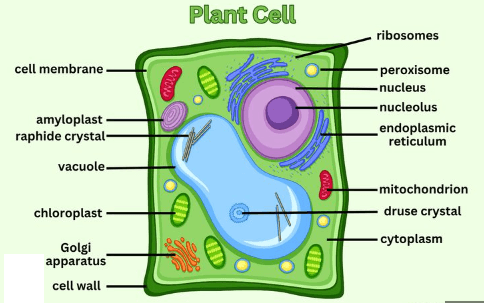
Types of Plant Cell
Plants have different types of cells that perform special tasks, helping the plant grow and stay healthy. The main types of plant cells are collenchyma, sclerenchyma, parenchyma, xylem, and phloem. Collenchyma cells give flexible support to young parts of the plant, while sclerenchyma cells provide stronger support to older parts.
Parenchyma cells store food and water and help heal the plant. Xylem cells move water and minerals from the roots to the rest of the plant, and phloem cells carry food made during photosynthesis. These cells work together to help the plant grow, survive, and function well throughout its life.
| Types of Plant Cells | |
| Cell Types | Functions |
| Parenchyma Cells | These are versatile cells that perform various functions, including photosynthesis in leaves, and they also store nutrients and assist in tissue repair. They have a thin cell wall and are found throughout the plant. |
| Collenchyma Cells | Unevenly thickened cell walls (corners), support and flexibility. |
| Sclerenchyma Cells | Thick, rigid cell walls with lignin, strength, and protection, dead at maturity. |
| Xylem Cells | Vessel elements and tracheids for water transport, support, and water transport. |
| Phloem Cells | Sieve tube elements and companion cells, transport of nutrients (sap), bidirectional movement of nutrients. |
Parenchyma Cells
Parenchyma cells are the types of plant cells that make up the bulk of plant cell that make up the bulk of plant tissues. They are essential for various biological functions, such as photosynthesis, storage, and support. These cells have a thin cell wall and large central vacuoles, allowing for flexibility and storage of nutrients and water. Additionally, parenchyma cells can undergo cell division, aiding in plant growth and repair. Due to their versatility, they are found in various plant organs, contributing to the plant’s overall structure and function.
Sclerenchyma Cells
Sclerenchyma cells are a type of plant cell known for their rigidity and strength. Unlike parenchyma cells, they have thick, dignified cell walls that provide structural support and protection to mature plants. Sclerenchyma cells come in two types: Fibers, which are long and slender cells that provide strength to plant tissues, and sclereids, which are shorter and irregularly shaped cells that offer protection to seeds and fruits. Due to their tough cell walls, sclerenchyma cells are often found in regions of plants that require mechanical support, such as the stems, bark, and seed coats.
Collenchyma Cells
Collenchyma cells are a type of plant cell that provides structural support to young growing plant parts. They are elongated, flexible, and have thick cell walls, which make them ideal for supporting tissues like stems and leaves. Collenchyma cells are alive and often found in areas of the plant that are still developing. They help the plant maintain its shape and resist mechanical stress while allowing for growth and flexibility.
Xylem Cells
Xylem cells are specialized plant cells that play a crucial role in transporting water, minerals, and nutrients from the roots to other parts of the plant, such as leaves and stems. They consist of various cell types, including tracheids and vessel elements, which form long, interconnected tubes. These cells are characterized by thick walls, providing structural support to the plant. As water is pulled up through the xylem, it helps maintain the plant’s hydration, supports photosynthesis, and contributes to the plant’s hydration, support to the plant. As water is pulled up through the xylem, it helps maintain the plant’s hydration, supports photosynthesis, and contributes to the plant’s overall growth and development.
Phloem Cells
Phloem cells are essential components of plant tissues responsible for transporting food, primarily sugars produced through photosynthesis, from the leaves to other parts of the plant, including roots, flowers, and fruits. These specialized cells, called sieve tubes and companion cells, form a network of tubes throughout the plant. Sieve tubes are responsible for the actual transport of nutrients, while companion cells support their function. This process, known as translocation, provides energy and nutrients to all plant cells, enabling growth, repair, and reproduction.
Parts of a Plant cell
A Plant Cell consists of numerous components that collaboratively enable it to perform vital functions within the plant’s body, including growth and responses to environmental challenges. The parts or components of a plant cell are named:
| Parts of a Plant Cell | |
| Parts | Description |
| Plasma Membrane | The plasma membrane, or cell membrane, is a semipermeable barrier surrounding cells, regulating the passage of substances and maintaining cellular integrity and communication. |
| Cell Wall | The cell wall is a rigid outer layer found in plant, fungal, and bacterial cells. It provides structural support, and protection, and maintains the cell’s shape and integrity. |
| Nucleus | The nucleus is a membrane-bound organelle within cells, containing genetic material (DNA) that controls cellular activities, including growth, metabolism, and reproduction. |
| Cytoplasm | Cytoplasm is a gel-like substance filling the cell, holding organelles in place. It’s essential for various cellular processes, providing structure and facilitating movement and communication within the cell. |
Plasma Membrane
The Cell membrane is an alternative term for the plasma membrane. The plasma membrane is the outer covering of each cell. It is a thin, semi-permeable barrier that surrounds the plant cell, separating its interior from the external environment. The plasma membrane is present in the cells of plants, animals, and microorganisms.
The plasma membrane plays a crucial role in controlling the passage of substances in and out of the cell. The plasma membrane also maintains cellular integrity and facilitates communications with neighboring cells and the environment.
Functions of a Plasma Membrane
- The plasma membrane helps in the regulation of the pathway so that the substances can pass through easily.
- The plasma membrane also provides structural support and maintains the shape of the plant cell.
- It controls the entry and exit of the molecules.
- The plasma membrane also helps to interact with neighboring cells for the transmission of signals.
Cell Wall
A cell wall is a Rigid outer layer found in the cells of a plant, algae, fungi, and some bacteria. A cell wall provides structural support and protection to the cell, which helps in maintaining its shape and preventing it from bursting. The composition of cell walls varies, but they often consist of complex Carbohydrates like cellulose in plant cells. Cellulose is the primary component of the plant’s cell wall, while the cell wall of fungi contains Chitin, and the bacterial cell wall is made up of Peptidoglycan.
Functions of the Cell Wall
- It helps the plant cell maintain turgidity. As the water enters the vacuoles through osmosis, the plant cell expands. To resist this expansion the cell wall has to be strong enough and so enables the cell to be turgid.
- The cell wall is freely permeable to water and substances in the solution.
- The cell wall provides mechanical strength to support the cell.
- The cell wall has narrow pores, through which fine strands of cytoplasm, called Plasmodesmata are able to pass. These help in the exchange of material between the living cell contents.
- The cell walls of the adjacent cells are attached or glued together by the Middle Lamella. The middle lamella is a jelly-like stuff that contains calcium and magnesium.
Nucleus
The nucleus is a vital organelle in plant cells. The nucleus is often referred to as the “control center” of the cell because it contains the cell’s genetic material, organized as DNA strands within chromosomes. The nucleus directs cellular activities by regulating gene expression and protein synthesis. The nuclear envelope, a double membrane, encircles the nucleus like a protective shell.
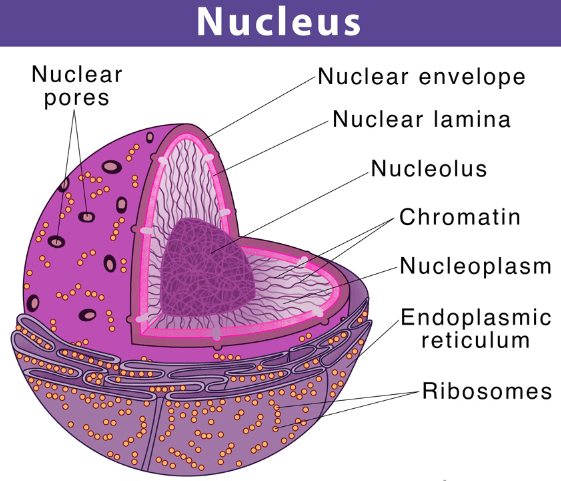
The nucleus has small pores that allow the movement of molecules between the nucleus and the cytoplasm. Within the nucleus, there is a nucleolus, which helps in the synthesis of Ribosomes. The information stored in the DNA within the nucleus provides instructions for the cell’s growth, development, and functioning.
Functions of a Nucleus
- The nucleus manages every metabolic activity that happens within the cell.
- If the nucleus is removed from the cell, the protoplasm ultimately dries up and dies.
- The nucleus helps in the regulation of the cell cycle.
- The Nucleus is concerned with the transmission of heredity traits from the parents to offspring.
Cytoplasm
The cytoplasm is a jelly-like substance that fills the space within a cell’s membrane. It’s a semi-fluid medium where various cellular activities take place. The cytoplasm is home to various organelles such as Mitochondria, Ribosomes, and the Endoplasmic Reticulum, and Golgi apparatus. Accept them the cytoplasm also contains water, enzymes, nutrients, and other molecules that support essential cellular processes like metabolism, protein synthesis, and energy production.
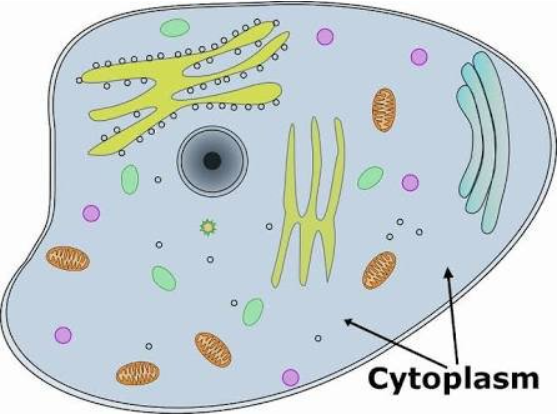
The inner grainy part of the cytoplasm is referred to as the Endoplasm, and the outer smooth layer is called the cell cortex or ectoplasm. The cytoplasm also consists of an aqueous ground substance, the cytosol, which contains a variety of cell organelles and other inclusions such as insoluble waste and storage products (like starch, glycogen, lipids, etc.).
Functions of a Cytoplasm
- The cytoplasm serves as a storage place for different chemicals like amino acids, glucose, vitamins, ions, and more.
- The cytoplasm is the site of certain metabolic pathways, such as glycolysis.
- Living cytoplasm is always in a state of movement.
Cell Organelles of Plant Cell
A cell does different jobs using its special parts called membrane-bound organelles. It has to synthesize substances such as protein synthesis by ribosomes, lipid synthesis on the surface of the Smooth Endoplasmic Reticulum (SER), and Photosynthesis of food such as glucose and starch by the Chloroplast. The cell also secretes cell products such as enzymes, hormones, mucus, etc. It has to digest all those substances which are taken up at the time of endocytosis. The cell also generates energy. So for all these activities, the cell has many different cell organelles which are named as:
- Endoplasmic Reticulum (ER)
- Ribosomes
- Golgi Apparatus
- Vacuole
- Chloroplasts
- Mitochondria
- Plastids
| Different Cell Organelles of Plant Cell | |
| Organelles | Description |
| Chloroplast | The chloroplast is a green organelle containing chlorophyll. The chloroplast is the site of photosynthesis and produces energy. |
| Mitochondria | Mitochondria is a double-membraned, site of cellular respiration. It produces ATP, the cell’s energy currency. |
| Endoplasmic Reticulum (ER) | Endoplasmic Reticulum is a network of membranes. It is of two types Rough endoplasmic and Smooth Endoplasmic Reticulum. |
| Golgi Apparatus | Golgi apparatus are stacks of flattened membranes. It modifies, sorts, and packages proteins and other materials for export. |
| Vacuole | Vacuoles are membrane-bound sacs containing water and nutrients. It stores substances and helps maintain cell turgor pressure. |
Endoplasmic Reticulum
The endoplasmic reticulum is a complex network of membranes within the cells that plays a very important role in the synthesis of proteins, and folding, and also helps in lipids metabolism. At one end the endoplasmic reticulum is attached to the outer membrane of the nucleus and on the other end it is connected to the plasma membrane. The Endoplasmic Reticulum is further divided into 2 parts:
- Rough Endoplasmic Reticulum
- Smooth Endoplasmic Reticulum
For more details about Rough and Smooth Endoplasmic Reticulum, you can also go through our article on The Difference Between Rough and Smooth Endoplasmic Reticulum.

Rough Endoplasmic Reticulum
The rough endoplasmic reticulum is a region that is covered with ribosomes on its cytoplasmic surface. These ribosomes are responsible for the synthesis of proteins within the cell. The rough endoplasmic reticulum is particularly important in the cells that produce a lot of proteins, like those in the pancreas that secret digestive enzymes or in immune cells that release antibodies.
Smooth Endoplasmic Reticulum
The smooth endoplasmic reticulum is a cell organelle involved in various functions, including lipid metabolism, detoxification, and calcium ion storage. The Smooth ER lacks ribosomes on its surface, which gives it a smooth appearance compared to rough ER. The smooth endoplasmic reticulum plays a very important role in the synthesis of lipids, metabolism of carbohydrates, and detoxification of drugs and toxins.
Functions of Endoplasmic Reticulum
- The endoplasmic reticulum forms a supporting skeleton framework of the cell.
- The endoplasmic reticulum provides a pathway for the distribution of nuclear material from one cell to the other.
- Certain enzymes present in the smooth endoplasmic reticulum synthesize fats (lipids), steroids, and cholesterol.
- The rough endoplasmic reticulum helps in the transport of proteins which are synthesized by ribosomes present on their surface.
Ribosomes
The ribosomes are fundamental cellular structures responsible for protein synthesis in plant cells. Ribosomes are made of large and small parts, containing ribosomal RNA (rRNA) and many proteins. In plant cells, there are ribosomes in the cytoplasm and some are attached to the endoplasmic reticulum (ER), which helps make proteins.
Cytoplasmic ribosomes create proteins for use inside the cell, like enzymes for different processes and structural proteins. The ribosomes in the ER make proteins that are sent out of the cell. These ribosomes are called “membrane-bound ribosomes” because they are attached to the membrane of the ER and help produce proteins needed outside the cell.
Functions of Ribosomes
- Ribosomes play a crucial role in protein synthesis.
- The ribosomes also regulate photosynthesis and Respiration in plants.
- They produce proteins that regulate the growth of the cells.
- The ribosomes are responsible for translating the genetic code stored in DNA into functional proteins.
Golgi Apparatus
An alternate term for the Golgi apparatus is the Golgi complex. It is a cellular organelle found in plant cells and among other eukaryotic cells. The Golgi apparatus is responsible for processing, packaging, and sorting proteins and lipids that are synthesized in the cell and then transported to various destinations within or outside the cell. The Golgi apparatus consists of a series of flattened sacs called cisternae and plays a very crucial role in intercellular transportation and secretion.
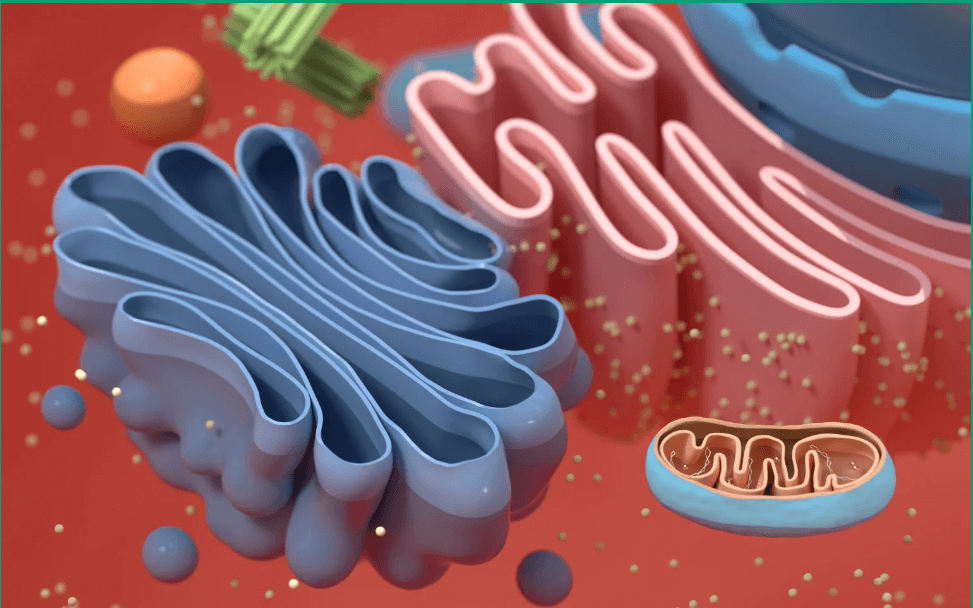
Functions of a Golgi Apparatus
- The main function of the Golgi apparatus is secretory.
- The Golgi works like a station where things are stored, processed, and packed before they’re sent out of the cell.
- The Golgi is also involved in the synthesis of cell walls, plasma membranes, and lysosomes.
- They produce vacuoles or secretory vesicles which contain cellular secretions.
Vacuoles
Vacuoles are the membrane-bound organelles present in the plant’s cell. The lysosomes are typically not present in the plant cells instead they have vacuoles. These vacuoles perform functions such as storage, waste disposal, and maintenance of cell turgor pressure. These vacuoles also play a very important role in plant growth, development, and responses to environmental changes. The vacuole is bounded by a membrane, called Tonoplast. The vacuole contains cell sap, a watery solution that holds sugars, amino acids, proteins, minerals, and waste products.
Functions of Vacuoles
- Vacuoles help in the maintenance of osmotic pressure in a cell.
- The vacuoles store toxic metabolic wastes or end products of the plant cell.
- They provide turgidity and rigidity to the plane cell.
Chloroplast
The chloroplast is an organelle found in the plant cell that is responsible for photosynthesis. Photosynthesis is the process by which plants convert light energy into chemical energy in the form of glucose. Chloroplast contains a special green pigment known as chlorophyll, this chlorophyll helps to capture light energy and plays a very important role in the production of food for plants. So chloroplasts are also known as the “Kitchen of the cell”.
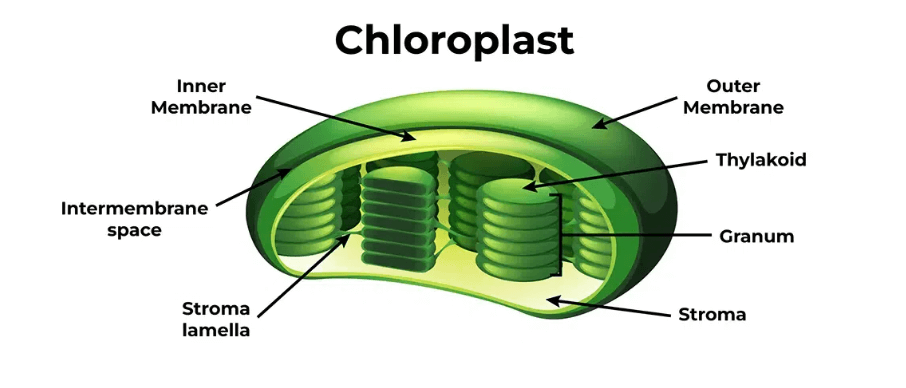
The chloroplast has two unit membranes and shows two distinct regions: The Grana and the Stroma. Grana consists of stacks of flat, disk-like sacs known as thylakoids, enclosed by membranes, and these thylakoids contain chlorophyll molecules. The Grana is the main functional unit of the chloroplast. Grana is the sight of light reaction during photosynthesis. The Stroma is a consistent matrix in which the grana are embedded. It contains a range of photosynthetic enzymes. The stroma is the sight of a dark reaction during photosynthesis.
Functions of a Chloroplast
- Chloroplast traps solar light and utilizes it to manufacture food for the plants.
- Chloroplasts impart various colors of flowers to attract insects for Pollination.
- Leucoplasts keep food stored as carbohydrates (starch), fats, and proteins.
Mitochondria
The mitochondria are membrane-bond organelles that are responsible for producing energy through cellular respiration. The mitochondria are commonly referred to as the “Power House of the Cell.” In plant cells, mitochondria play a very important role in the generation of ATP (Adenosine Triphosphate) which is used as an energy source for various cellular processes. The Mitochondria are bounded by double membrane envelopes. The folds present on the mitochondria are known as Cristae and are dotted with small round bodies known as Oxysomes.

Functions of Mitochondria
- Mitochondria is a sight for cellular respiration.
- The energy is stored in the form of ATP in the mitochondria of the cell.
- Mitochondria are able to make some of their own proteins; so they are known as Semiautonomous Organelles.
Plastids
Plastids are membrane-bound organelles found in the plant cell. They are responsible for various functions such as photosynthesis, storage of pigments, and synthesis of lipids. The plastids are of three types and are named Chloroplasts, Leucoplasts, and Chromoplasts. Chloroplasts are a type of plastids that are involved in photosynthesis, and they are green in color. While chromoplasts store pigments like carotenoids, they are irregular in shape and range from brownish to reddish in color. The Leucoplasts help in the storage of starches and oils. The leucoplasts are cylindrical or rounded in shape and are mostly colorless.
Functions of the Plastids
- Chloroplasts are a type of plastid responsible for photosynthesis, where they convert sunlight into energy (glucose) by capturing and storing solar energy in the form of carbohydrates.
- Some plastids, like amyloplasts, store starch, while others, like chloroplasts, store pigments such as carotenoids. These stored substances serve as an energy reserve or contribute to the coloration of fruits and flowers.
- Certain plastids, called oleoplasts, are involved in the synthesis and storage of fats and oils.
- Leucoplast another type of plastid, can synthesize amino acids and proteins important for plant growth and development.
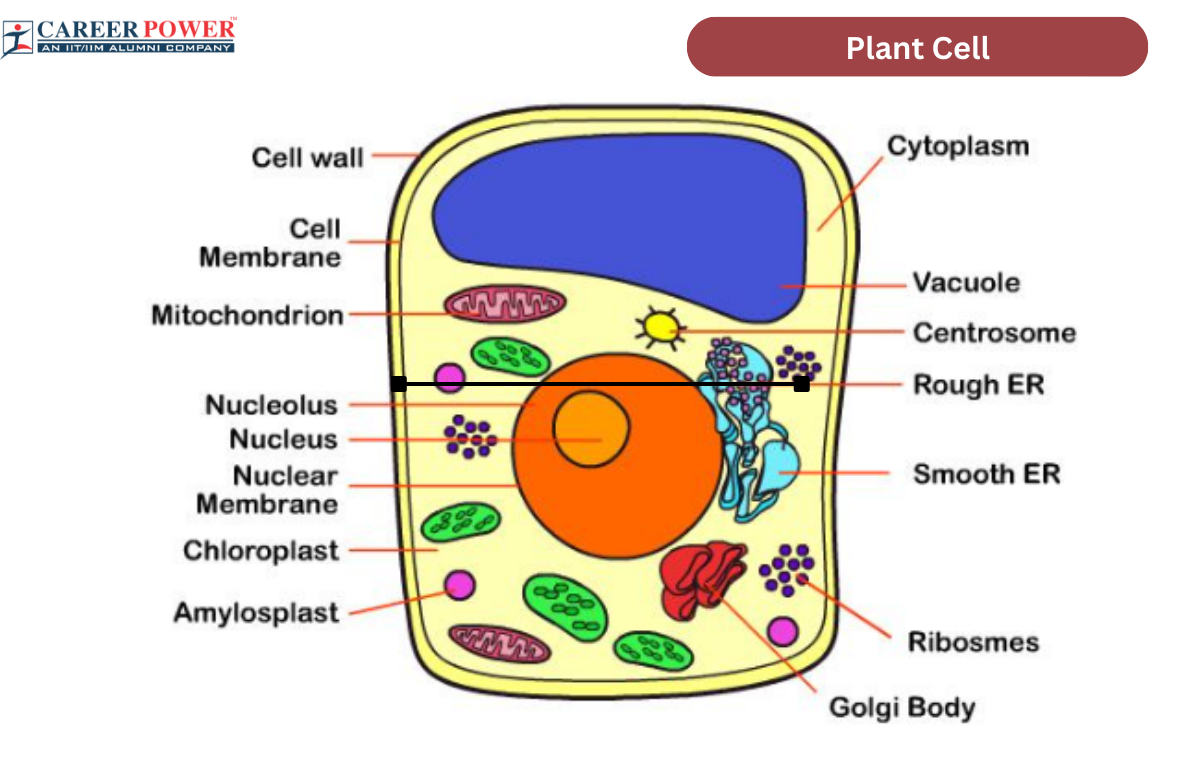

 50 Vegetables Name for Kids in English a...
50 Vegetables Name for Kids in English a...
 Body Parts Name, All 50 Body Parts Name ...
Body Parts Name, All 50 Body Parts Name ...
 Flowers Names in English and Hindi, List...
Flowers Names in English and Hindi, List...









